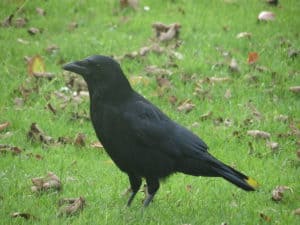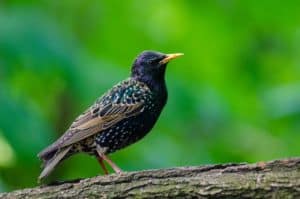Birds are cute, but they can turn into a nuisance in some situations. Some birds can turn your clean surfaces with their droppings into a dirty mess, something that would make you want to keep them away at all costs.
If you live in a coastal area, you probably have experience with albatrosses already – they often hang around waiting to snatch unattended items and small pets like kittens and dogs.
After munching on seeds and everything else the whole day, birds will perch on your structures and ruin the harmony of your manufactured home with everything from leftover food to smelly droppings. There ought to be a way to keep them at bay.
How to Choose the Best Manufactured Home Bird Deterrent – Eight Factors

When planning to ward off the offending birds, there is always a list of factors that need to be put into consideration on the choice of the method among other things.
Fortunately, with birds, there are just a fistful of things that actually pass as harmful. Every individual’s scenario is different so let us break down what could cause you to opt for one method over another.
1. Effectiveness
How effective is the deterrent?
You want to buy a device that’s going to work better than other options.
So, it is important that you peruse through the reviews of the deterrent of your liking or get your recommendations from users who have actually tried the product.
Normally the most effective method is the one that gets the user from A to B real fast.
Look out – you could easily splash a fortune on a repellant or fogger that may fail to work or require a great deal of maintenance.
2. Simplicity
Simple products are always the best – you don’t want to go through a steep learning curve just to understand how a certain bird deterrent works.
It is already bad enough that you’re dealing with rogue birds, the last thing anyone could suggest is to spend more hours setting up a complex product and even more hours trying to maintain it.
Most of the bird deterrents you will find in the store will give you an easier time during set up.
They also tend to be the “set-up-and-forget” kind of products – you put them there and forget everything until the day they will need a replacement. But that’s just a few of them. Some of them can still be a real headache to set up and run.
If you are looking for a deterrent that’s easier to set up and maintain, then we’d recommend reflective devices. Another advantage of reflective devices is their ability to work flawlessly even when you are not around
Also, reflective devices don’t require maintenance over time. If you are looking for the most durable method of keeping those offending birds at bay, you should probably go for a reflective device.
3. Life Cycle
Another factor worth considering when buying a deterrent is longevity. You don’t want to go for a product that will become ineffective in a matter of days or weeks.
Some deterrents, especially reflective devices, tend to fade or lose their abilities with time.
When checking out the products’ reviews on the internet and making up your mind on one product, you want to keenly look at the reviews that talk about the durability of the product and whether it would be a long-lasting option for you.
The more durable the deterrent is, the better.
4. What Kind of Birds Do You Wish to Get Rid of?
Know the intruder.
Not every bird is harmful.
You need to be particular with your deterrents and only keep away the bad guys. Owing to the diverse nature of the bird family, it can be a little hard to target just one kind of bird and leave out others.
However, because specific species will flock together and perch in specific areas or feed on particular kinds of foods, your deterrent can narrow down to these aspects to control them.
5. Human Safety
In some circumstances, humans are affected by some bird deterrents as well, particularly the supersonic types, ultrasound, and gels when the protected area borders the human habitat.
Those that involve hot chili pepper sprays may cause eye and nose irritation if people get exposed to them. Also, the plangent sound of trapped moaning can irritate nearby individuals.
6. The Area
Consider the area or surface. Some bird control methods are efficient or effective for cramped areas while others are perfect for a larger area.
For example, it is recommended that you use scare taps, decoy predators, and hanging reflective devices to drive birds away from a small balcony.
But for a large playground or field or even a farm, you definitely require special devices such as ultrasound or supersonic noise producers to cover the area from one corner to another.
7. Aesthetic
Bird repellents shouldn’t ruin the good view of your home and buildings.
Also, the repellant should not be all over the place.
If every free inch of your balcony or garden fence is covered with spikes to ward off unwanted birds and other animals, it would be spooky for your good neighbors as well.
Some methods won’t look good on some surfaces. For example, if you want to keep pigeons at bay on a large and crowded, covering the whole surface with a reflective paper would create an eyesore to people and other animals.
8. Weather
The weather can affect the effectiveness of the deterrent.
Hanging reflective deterrents is only practical during sunny summers, not during the grey winter.
Conversely, water jets would be useless if you live in a frost climate because water could be freeze. In such a situation, a large scarecrow would be a better option.
Related: How Do You Keep Your Neighbor’s Chickens Out of Your Yard?
Three Methods to Avoid

There are less ethical bird control methods that, while they make be highly effective, might end up producing adverse results. to keep birds away. Avoid deterrence methods that involve these techniques:
1. Hardware Screening
Bird screens come as fine nets that can be installed on walls or fences.
These nets are normally invisible to flying birds, so they will hit themselves in I and struggle a bit before rerouting.
Hardware screening is the most effective method of keeping birds away from your garden, but often ends up injuring and sometimes traps unintended animals.
2. Plastic Netting
Very much like hardware screening, plastic netting tends to trap or entangle the birds in the network, and this can become a larger problem because they can easily rustle around enough to actually harm themselves as well as your crops or anything else you are trying to protect.
3. Chemicals
Chemical solutions can help get rid of birds just as effectively as most other methods, or even better off.
What makes chemical solutions more attractive is their cost-effectiveness and a wide range of chemicals to choose from.
The major downside of these chemicals, however, is that they often end up in the digestive system of other harmless animals, sometimes killing them.
Related: Can A Manufactured Home Get Termites?
How A Typical Bird Deterrent Work – Three Ways
Most bird deterrents work in one of the three common ways:
- they physically stop the birds from landing on a surface
- simply create a distaste
- they frighten them
1. Fear
Small birds can be easily frightened by anything that resembles their natural predator like owls and hawks.
Owls are their worst predators, catching virtually all types of birds whenever a chance presents itself. Hawks and eagles too are.
Foxes, bobcats, and coyotes, and sometimes crocodiles will scare them away.
Simple sudden movements alone are enough to scare the hell out of any bird, causing them to fly away in response.
Recommendations
Bird-X Scare-Eye Bird Repellent Predator Eyes Balloons


These balloons can be hung up in the air in the areas you want to discourage the birds.
They come with large brightly colored owl-like eyes enough to frighten even the boldest flock.
Bird B Gone MMRTH1 Hawk Decoy


This Hawk decoy can like a real hawk perched on your fence keenly looking around for any unfortunate bird.
2. Distaste
Specific kinds of birds will find some specific taste or odor offensive.
When they come across something that doesn’t taste great to them, they will pull away – that’s the substance you should use to keep them off.
Caustic or sticky substances like gels and glues will prevent birds from landing anywhere they are smeared.
Recommendation
Bird-X Bird-Proof Gel Bird Repellent
This gel-like sticky substance prevents birds from roosting or perching on surfaces.
This product is very different from the holographic bird control methods we’re used to because it doesn’t deter the birds from a long distance.
It comes as a caulk-like material and acts as an adhesive surprise to unwanted birds and animals once they land on it. Accordingly, no bird would roost on a surface with such a sticky and unpleasant substance.
You just smear the gel on surfaces where you do not birds fly to or land, particularly windowsill, roof, or drainage hole. The best thing is that the gel is transparent, a feature that helps maintain your house integrity and remain invisible.
This gel is made from polybutene, which is perfectly safe for all bird species, the environment, and humans. It’s sticky enough to irritate birds, but not good home pets like cats and dogs.
Pros
- Totally effective and still not harmful to birds (woodpeckers, pigeons)
- Easy to apply
- Transparent gel
- Not much hampered by weather conditions
Cons
- Several small birds may get stuck on it, never to escape
- Small pieces of unwanted pieces of stuff are collected trapped by the gel, requiring frequent replacement
3. Physical Prevention
Physical prevention, or the exclusion method, physically prevents birds from flying into the protected area using plastic windows or nets. The windows on your car or house are a good example of physical deterrence. Physical prevention can also come as spikes or metal rods that prevent the birds from landing on the protected surface.
Recommendations:
Bird-X Stainless Steel Bird Spikes


Spikes are old school bird deterrents. Their mode of action is simple – prevents the birds from landing their dirty little legs on your fence or wherever you don’t want them to set foot.
This specific product from Bird-X is made from stainless steel, meaning it will remain outdoors for a long time without rusting and requiring replacement.
The spikes are installed with screws and staples which makes it easy to deploy or remove when they are no longer needed.
Pros
- Stainless steel construction – not easily affected by moisture or weather conditions
- Plastic base – easy to trim and adjust into the right length
- A firm and flexible base that lines up flawlessly on curved surfaces
Cons
- Work only on places they have been directly installed
4. Noise

There are noises birds will find intimidating. High pitched noises and loud bangs are always effective. Noise deterrents should be set up in such a way that they are only uncomfortable to birds.
Some deterrents are designed to mimic the bird’s behavior. Matching the noises to the birds’ behavior is key. Deterrents of this type are typically sonic devices.
There are 2 types of sonic equipment perfect for scaring birds:
- distress call deterrents
- noise deterrents
Distress Deterrents
Distress call devices imitate the bird’s natural songs and communication sounds.
Most birds relay details about the danger to members of the flock via the use of distress calls.
These cheeky devices broadcast a nearly exact copy of this call to scare the rest of the flock away.
But because these calls tend to be species-specific, you will need to buy the right distress cry for the specific type of birds you’re handling.
Noise Deterrents
Irritating noise deterrents, on another hand, are effective at scaring them birds by producing random loud noises that upset the flock.
Air guns, air horns, and simple banging pans and pots together are all good examples of frightening noise producers.
For any sonic device to be effective, it should be used together with visual devices. It should also be timed to the offending bird’s behavior.
This can be a bit hard because it may mean you’re waiting until the flock returns to their roosting grounds late in the afternoon and then stun them with a loud bang or distress calls accompanied by threatening movements.
It could take several days to scare the birds. To be effective and last longer, don’t leave the device to produce the noise constantly; this allows the bird to learn that the noises aren’t paired to their real behavior.
Recommendation
Izbie Z1 Ultrasonic Bird Repellant


This high-tech device uses a combination of ultrasound and flashing lights to keep off the bird.
Many birds can detect ultrasounds and interpret it as danger. The best thing about this device is that it does not blind the birds or other harmless animals that may be wandering around.
Pros
- Deters most kinds of birds and other large animals such as deer, bats, and snakes
- 5 modes of adjustment
- Comes with rechargeable solar battery and USB port
- Can withstand adverse weather conditions
Cons
- Ultrasound may end up affecting nearby humans, particularly babies
5. Dazzling Lights

Birds can also be frightened by unexpected bright lights which may blind them when they are trying to fly.
The best thing about light-based deterrents is that they are permanent – once they are installed, you don’t need to be around or keep making adjustments for them to work.
Most of the dazzlers you will find in the store don’t discourage birds by producing real light, but rather, reflecting the sunlight. They are impressively effective nevertheless.
Recommendations:
Chephon Bird Repellent Discs Set


This product consists of a string of shiny discs complete with mirrored surfaces on the two sides, which serves to reflect the sunlight at the optimum.
It’s simple to attach the disc together. All you need to do is connect individual discs with their provided rings. Remember to remove and dispose of transparent films on both sides.
Pros
- Lightweight
- Easy to assemble
- You can adjust the number of discs on a strings
Cons
- The drilled holes may be cracked with increased time of use
BRITENWAY Premium Quality Reflective Scare Tape Ribbon
This product comes as thin strips of silvery and highly reflective sheets of paper. You don’t even need to hold them on the surface with screws or staples – just tie or hang them there and birds will be dazzled back to where they are coming from.
Pros
- Uses reflective sunlight and flapping sounds to discourage the birds
- Hangs up effortlessly on any spot
- Adds a party-look to your arch, fence, or any surface
Cons
- Don’t work perfectly against larger birds like pigeons
- Ineffective against night birds as it relies on sunlight
Final Thoughts – Are Bird Deterrents Even Effective?
It depends on the type of deterrent, but conventional methods do work sometimes.
The only methods that can guarantee 100 percent effectiveness are solid glass windows and mesh screens.
All others will work with varying percentages of effectiveness.
But that doesn’t mean they won’t be recommendable for the task.
Related: How Can You Keep Animals from Digging Underneath a Manufactured Home?



